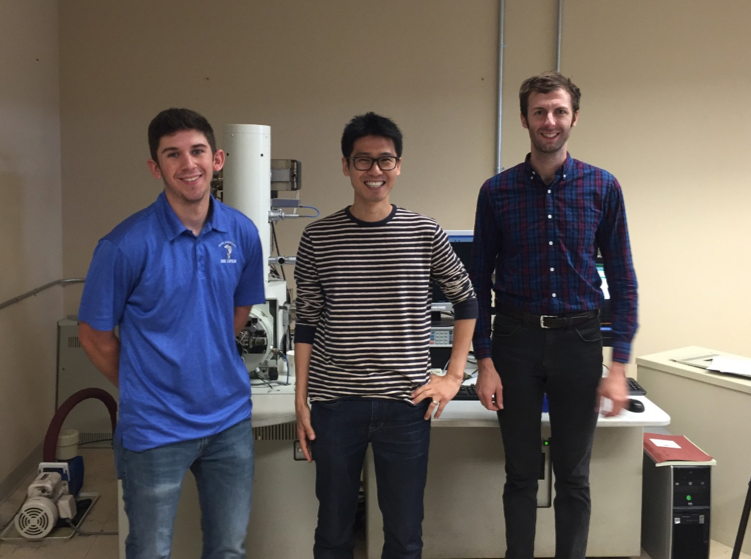MSE Faculty’s Research Explores Materials for Space
By Amanda Campanaro

John Sypek and Keith Dusoe, both third-year Ph.D. students, are working on superelasticity and cryogenic shape memory effect of ThCr2Si2-type intermetallic compounds. (Left to right: John Sypek, Seok-Woo Lee, Keith Dusoe)
Each year, NASA accepts a select number of proposals from Early Career Faculty (ECF) at accredited U.S. Universities to award a generous research grant for three years of funding and the opportunity to further research into space exploration. This year, MSE Pratt & Whitney Assistant Professor Seok-Woo Lee’s proposal, “Development of Small-Volume, High-Precision, and Reliable Cryogenic Linear Actuators by Using Novel Intermetallic Compounds,” was accepted for an ECF award.
The Early Career Faculty award is one of the Space Technology Research Grants Program awards granted to universities on behalf of outstanding faculty researchers early in their careers. ECF challenges faculty to examine the theoretical feasibility of ideas and approaches that are critical to making science, space travel, and exploration more effective, affordable, and sustainable.
“Our project aims at a scientific understanding of shape memory effects below 50 K in ThCr2Si2-type intermetallic compounds as well as developing a proto-type cryogenic linear actuator that can be used as a sensor and a switching device in deep cold space, at about 3 K,” says Dr. Lee.
ThCr2Si2-type intermetallic compounds exhibit superelasticity and shape memory effects through the reversible phase transformation between orthorhombic and collapsed tetragonal phases. This is completely different from the conventional martensitic-austenitic phase transformation observed in most shape memory materials. What is crucial to their proposal is that these intermetallic compounds exhibit strong shape memory effects below 100 K, which has never been observed before, Dr. Lee explains.

Sn-solution grown CaFe2As2 single crystal exhibits the reversible deformation-induced phase transformation between orthorhombic (or tetragonal) and collapsed tetragonal phases by forming As-As bonding under compression along c-axis of the unit cell. This reversible phase transformation enables superelasticity and thermal actuation above 100 K, and shape memory effects below 100 K.
“The results of our research will represent a paradigm shift in the area of shape memory materials, enable a new design of cryogenic linear actuators, sensors, and switching devices for deep space exploration, and more broadly, suggest a mechanistic path to a whole new class of shape memory materials,” says Dr. Lee. A visual of their research can be seen below.
The results were achieved through collaboration among lab mates, and among universities. Over the last two years, Dr. Lee has worked as part of a research team to investigate superelasticity and shape memory effects of ThCr2Si2-type intermetallic compounds. This team includes Professor Paul C. Canfied’s group at Iowa State University, Professor Christopher R. Weinberger’s group at Colorado State University, and Ames Laboratory, which, Dr. Lee said, contributes by growing a single crystal using solution growth technique.
“My research team characterizes mechanical properties, which are the most important data in this project,” he says. Meanwhile, Professor Christopher R. Weinberger’s group performs Density Functional Theory simulations to investigate the atomic-scale processes of superelasticity and shape memory effects. The team’s combined capabilities of synthesis, measurement, and theory enables them to pursue excellent research on these materials. Currently, Dr. Lee’s team leads this project.
The proposal was made in conjunction with Ph.D. students John Sypek and Keith Dusoe’s experimental results which were gathered during Dr. Lee’s first two years at UConn. “I am very happy to see that NASA accepted our preliminary results and potential to develop a new cryogenic actuation technology,” he says. The funding will allow John Sypek and Keith Dusoe, his first two Ph.D. students, to continue to pursue an understanding of the unique mechanical properties of ThCr2Si2-type intermetallic compounds, and to develop their practical applications.
Published: September 21, 2016
Categories: awards, faculty, news, research
Available Archives